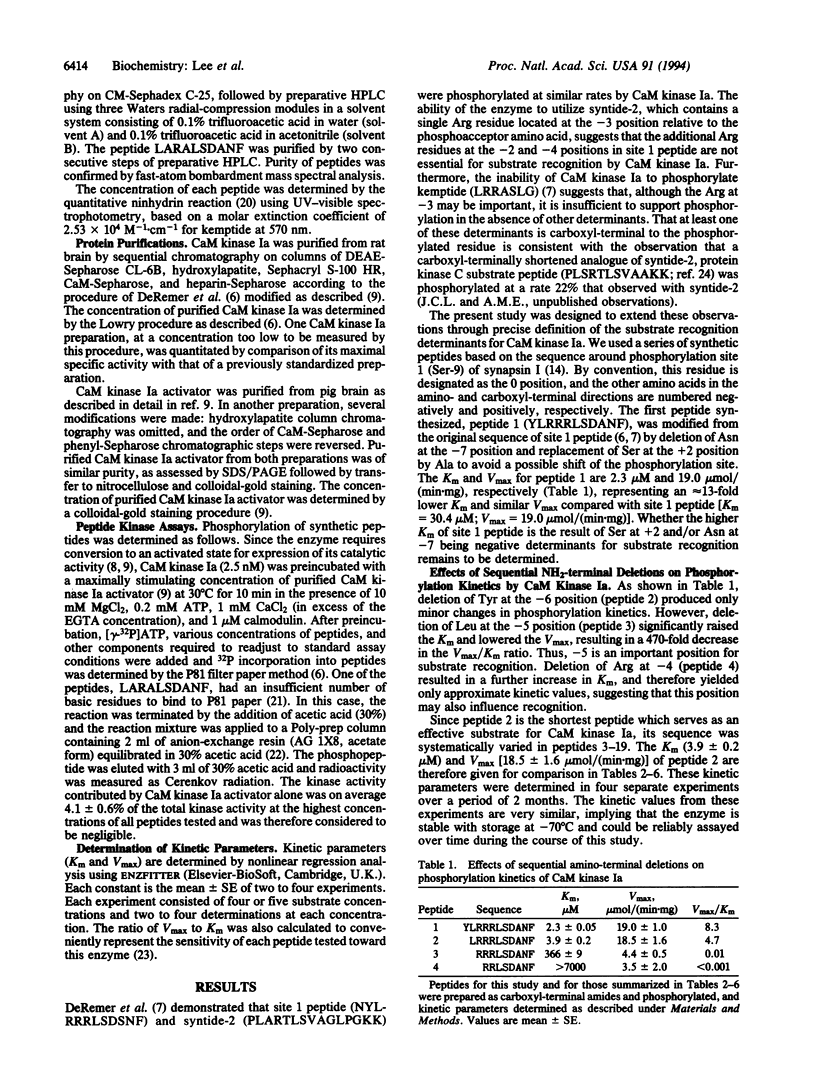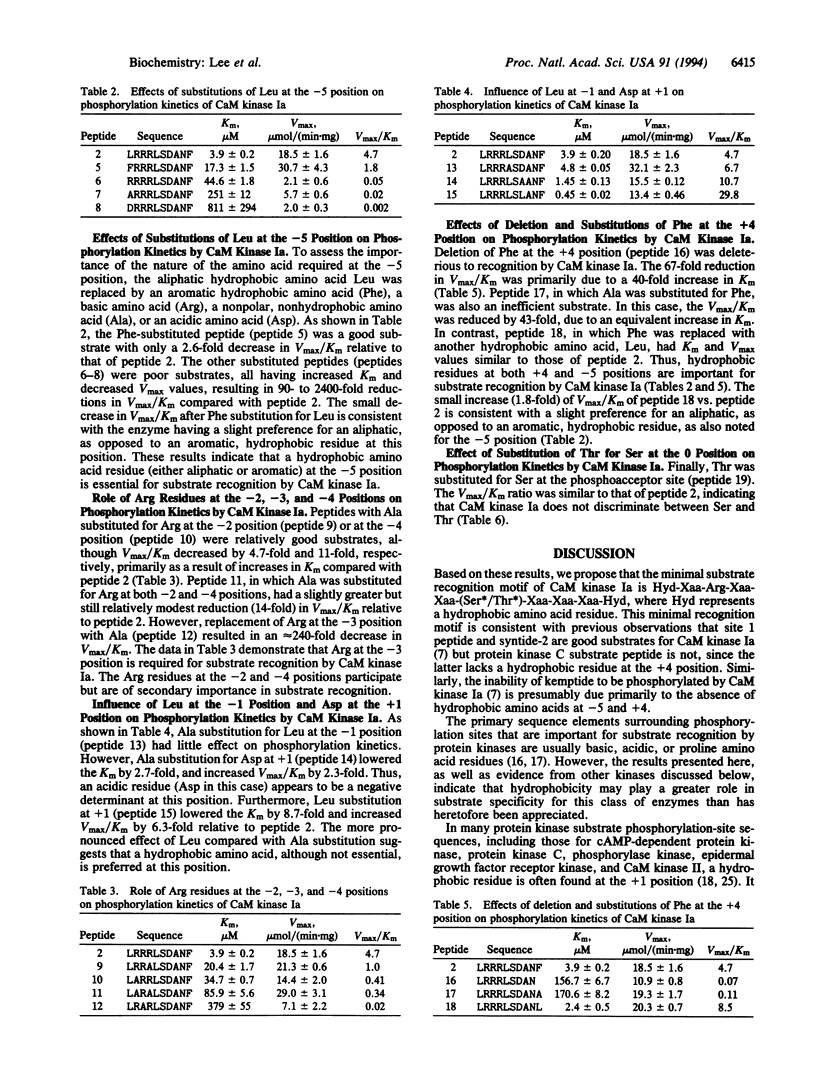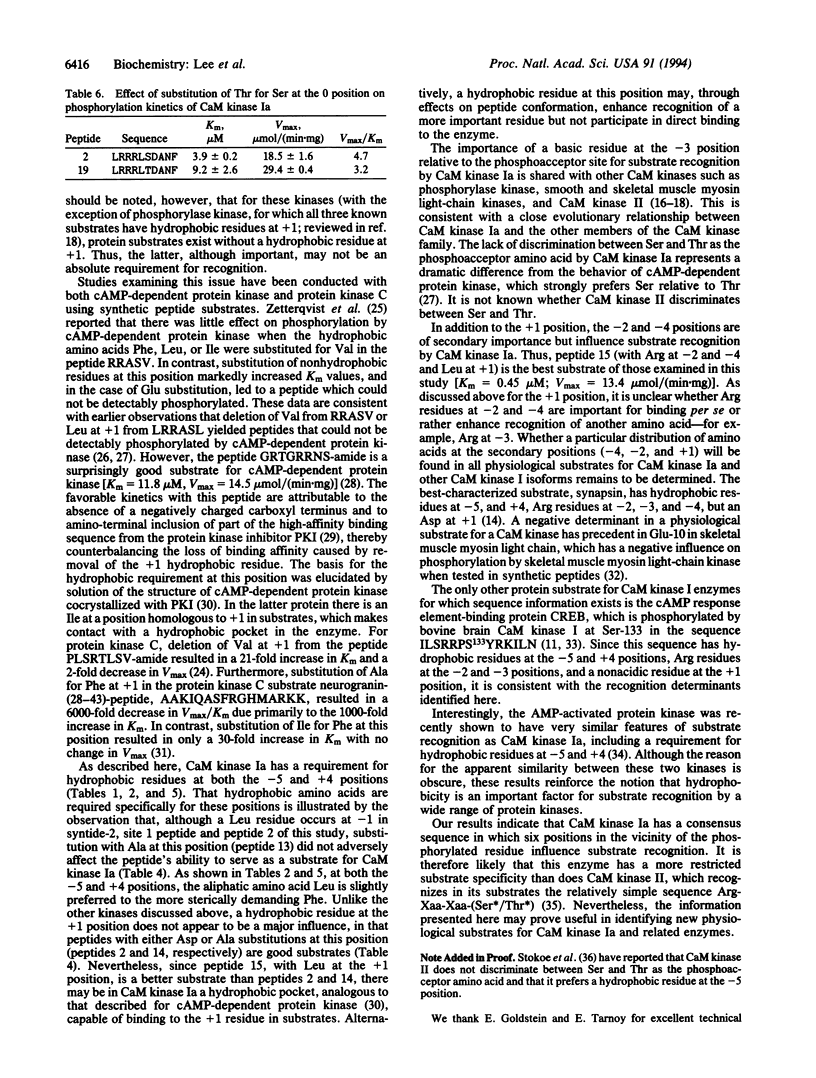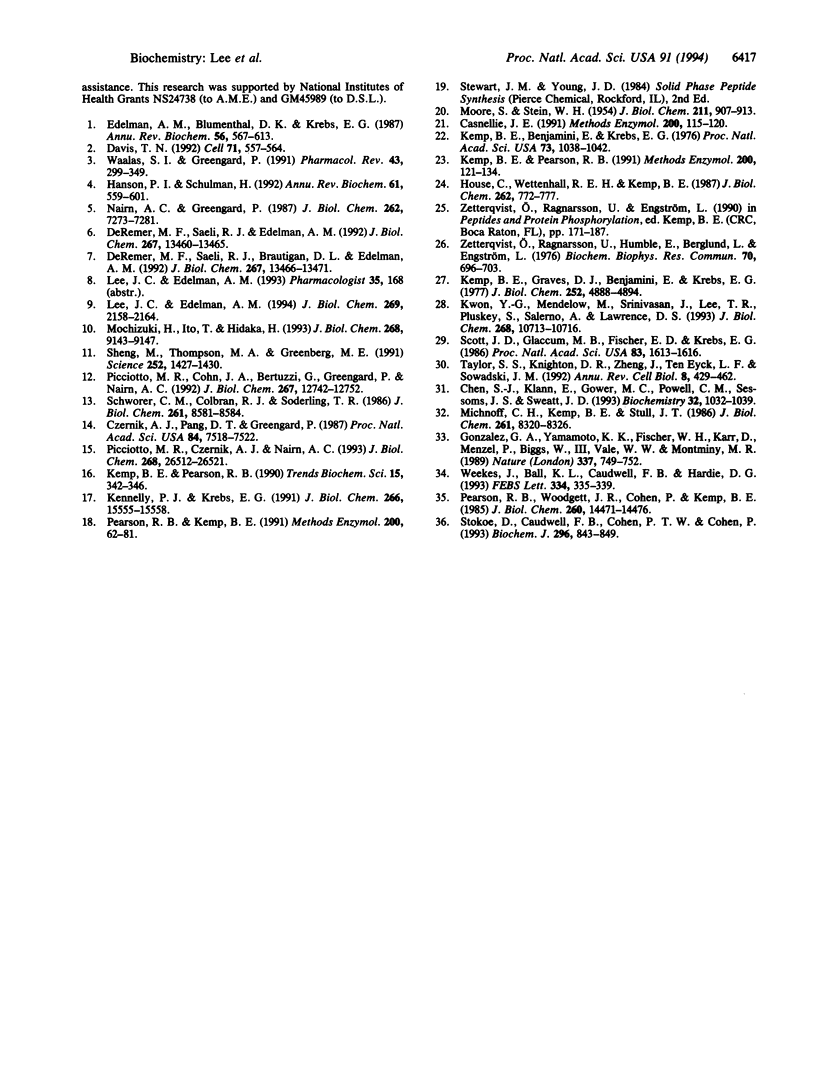Abstract
The substrate recognition determinants of Ca2+/calmodulin-dependent protein kinase Ia were investigated by using peptide analogues based on the amino acid sequence around Ser-9 of synapsin I. The Km and Vmax for the synthetic peptide Leu-Arg-Arg-Arg-Leu-Ser-Asp-Ala-Asn-Phe are 3.9 microM and 18.5 mumol/(min.mg), respectively. Deletion of Leu at the -5 position lowers the Vmax/Km by 470-fold. The requirement for a hydrophobic residue at -5 was confirmed by the 90- to 2400-fold reduction in Vmax/Km produced by Arg, Ala, or Asp substitutions, but only 2.6-fold decrease after Phe substitution at this position. A hydrophobic residue is similarly required at the +4 position. Deletion of Phe at this position produces a 67-fold reduction, and substitution of Ala for Phe a 43-fold reduction in Vmax/Km. In contrast, substitution with Leu increases Vmax/Km by 1.8-fold. Arg at -3 is also required for recognition as shown by an approximately 240-fold decrease in Vmax/Km after Ala substitution at this position. Positions -2, -4, and +1 appear to play secondary roles in substrate recognition. Arg at -2 and -4 are positive determinants, since Ala substitution at these positions decreases Vmax/Km by 4.7- and 11-fold, respectively. Asp at +1 is a negative influence, since Ala and Leu substitutions at this position increase Vmax/Km by 2.3- and 6.3-fold, respectively. Substitution of Ala for Leu at -1 or Thr for Ser at the 0 position has little effect on phosphorylation kinetics. Thus, Ca2+/calmodulin-dependent protein kinase Ia has the minimal substrate recognition motif of Hyd-Xaa-Arg-Xaa-Xaa-(Ser*/Thr*)-Xaa-Xaa-Xaa-Hyd, where Hyd represents a hydrophobic amino acid residue.
Full text
PDF




Selected References
These references are in PubMed. This may not be the complete list of references from this article.
- Casnellie J. E. Assay of protein kinases using peptides with basic residues for phosphocellulose binding. Methods Enzymol. 1991;200:115–120. doi: 10.1016/0076-6879(91)00133-h. [DOI] [PubMed] [Google Scholar]
- Chen S. J., Klann E., Gower M. C., Powell C. M., Sessoms J. S., Sweatt J. D. Studies with synthetic peptide substrates derived from the neuronal protein neurogranin reveal structural determinants of potency and selectivity for protein kinase C. Biochemistry. 1993 Feb 2;32(4):1032–1039. doi: 10.1021/bi00055a006. [DOI] [PubMed] [Google Scholar]
- Czernik A. J., Pang D. T., Greengard P. Amino acid sequences surrounding the cAMP-dependent and calcium/calmodulin-dependent phosphorylation sites in rat and bovine synapsin I. Proc Natl Acad Sci U S A. 1987 Nov;84(21):7518–7522. doi: 10.1073/pnas.84.21.7518. [DOI] [PMC free article] [PubMed] [Google Scholar]
- Davis T. N. What's new with calcium? Cell. 1992 Nov 13;71(4):557–564. doi: 10.1016/0092-8674(92)90590-9. [DOI] [PubMed] [Google Scholar]
- DeRemer M. F., Saeli R. J., Brautigan D. L., Edelman A. M. Ca(2+)-calmodulin-dependent protein kinases Ia and Ib from rat brain. II. Enzymatic characteristics and regulation of activities by phosphorylation and dephosphorylation. J Biol Chem. 1992 Jul 5;267(19):13466–13471. [PubMed] [Google Scholar]
- DeRemer M. F., Saeli R. J., Edelman A. M. Ca(2+)-calmodulin-dependent protein kinases Ia and Ib from rat brain I. Identification, purification, and structural comparisons. J Biol Chem. 1992 Jul 5;267(19):13460–13465. [PubMed] [Google Scholar]
- Edelman A. M., Blumenthal D. K., Krebs E. G. Protein serine/threonine kinases. Annu Rev Biochem. 1987;56:567–613. doi: 10.1146/annurev.bi.56.070187.003031. [DOI] [PubMed] [Google Scholar]
- Gonzalez G. A., Yamamoto K. K., Fischer W. H., Karr D., Menzel P., Biggs W., 3rd, Vale W. W., Montminy M. R. A cluster of phosphorylation sites on the cyclic AMP-regulated nuclear factor CREB predicted by its sequence. Nature. 1989 Feb 23;337(6209):749–752. doi: 10.1038/337749a0. [DOI] [PubMed] [Google Scholar]
- Hanson P. I., Schulman H. Neuronal Ca2+/calmodulin-dependent protein kinases. Annu Rev Biochem. 1992;61:559–601. doi: 10.1146/annurev.bi.61.070192.003015. [DOI] [PubMed] [Google Scholar]
- House C., Wettenhall R. E., Kemp B. E. The influence of basic residues on the substrate specificity of protein kinase C. J Biol Chem. 1987 Jan 15;262(2):772–777. [PubMed] [Google Scholar]
- Kemp B. E., Benjamini E., Krebs E. G. Synthetic hexapeptide substrates and inhibitors of 3':5'-cyclic AMP-dependent protein kinase. Proc Natl Acad Sci U S A. 1976 Apr;73(4):1038–1042. doi: 10.1073/pnas.73.4.1038. [DOI] [PMC free article] [PubMed] [Google Scholar]
- Kemp B. E., Graves D. J., Benjamini E., Krebs E. G. Role of multiple basic residues in determining the substrate specificity of cyclic AMP-dependent protein kinase. J Biol Chem. 1977 Jul 25;252(14):4888–4894. [PubMed] [Google Scholar]
- Kemp B. E., Pearson R. B. Design and use of peptide substrates for protein kinases. Methods Enzymol. 1991;200:121–134. doi: 10.1016/0076-6879(91)00134-i. [DOI] [PubMed] [Google Scholar]
- Kemp B. E., Pearson R. B. Protein kinase recognition sequence motifs. Trends Biochem Sci. 1990 Sep;15(9):342–346. doi: 10.1016/0968-0004(90)90073-k. [DOI] [PubMed] [Google Scholar]
- Kennelly P. J., Krebs E. G. Consensus sequences as substrate specificity determinants for protein kinases and protein phosphatases. J Biol Chem. 1991 Aug 25;266(24):15555–15558. [PubMed] [Google Scholar]
- Kwon Y. G., Mendelow M., Srinivasan J., Lee T. R., Pluskey S., Salerno A., Lawrence D. S. The active site substrate specificity of the cAMP-dependent protein kinase. J Biol Chem. 1993 May 25;268(15):10713–10716. [PubMed] [Google Scholar]
- Lee J. C., Edelman A. M. A protein activator of Ca(2+)-calmodulin-dependent protein kinase Ia. J Biol Chem. 1994 Jan 21;269(3):2158–2164. [PubMed] [Google Scholar]
- MOORE S., STEIN W. H. A modified ninhydrin reagent for the photometric determination of amino acids and related compounds. J Biol Chem. 1954 Dec;211(2):907–913. [PubMed] [Google Scholar]
- Michnoff C. H., Kemp B. E., Stull J. T. Phosphorylation of synthetic peptides by skeletal muscle myosin light chain kinases. J Biol Chem. 1986 Jun 25;261(18):8320–8326. [PubMed] [Google Scholar]
- Mochizuki H., Ito T., Hidaka H. Purification and characterization of Ca2+/calmodulin-dependent protein kinase V from rat cerebrum. J Biol Chem. 1993 Apr 25;268(12):9143–9147. [PubMed] [Google Scholar]
- Nairn A. C., Greengard P. Purification and characterization of Ca2+/calmodulin-dependent protein kinase I from bovine brain. J Biol Chem. 1987 May 25;262(15):7273–7281. [PubMed] [Google Scholar]
- Pearson R. B., Kemp B. E. Protein kinase phosphorylation site sequences and consensus specificity motifs: tabulations. Methods Enzymol. 1991;200:62–81. doi: 10.1016/0076-6879(91)00127-i. [DOI] [PubMed] [Google Scholar]
- Pearson R. B., Woodgett J. R., Cohen P., Kemp B. E. Substrate specificity of a multifunctional calmodulin-dependent protein kinase. J Biol Chem. 1985 Nov 25;260(27):14471–14476. [PubMed] [Google Scholar]
- Picciotto M. R., Cohn J. A., Bertuzzi G., Greengard P., Nairn A. C. Phosphorylation of the cystic fibrosis transmembrane conductance regulator. J Biol Chem. 1992 Jun 25;267(18):12742–12752. [PubMed] [Google Scholar]
- Picciotto M. R., Czernik A. J., Nairn A. C. Calcium/calmodulin-dependent protein kinase I. cDNA cloning and identification of autophosphorylation site. J Biol Chem. 1993 Dec 15;268(35):26512–26521. [PubMed] [Google Scholar]
- Schworer C. M., Colbran R. J., Soderling T. R. Reversible generation of a Ca2+-independent form of Ca2+(calmodulin)-dependent protein kinase II by an autophosphorylation mechanism. J Biol Chem. 1986 Jul 5;261(19):8581–8584. [PubMed] [Google Scholar]
- Scott J. D., Glaccum M. B., Fischer E. H., Krebs E. G. Primary-structure requirements for inhibition by the heat-stable inhibitor of the cAMP-dependent protein kinase. Proc Natl Acad Sci U S A. 1986 Mar;83(6):1613–1616. doi: 10.1073/pnas.83.6.1613. [DOI] [PMC free article] [PubMed] [Google Scholar]
- Sheng M., Thompson M. A., Greenberg M. E. CREB: a Ca(2+)-regulated transcription factor phosphorylated by calmodulin-dependent kinases. Science. 1991 Jun 7;252(5011):1427–1430. doi: 10.1126/science.1646483. [DOI] [PubMed] [Google Scholar]
- Stokoe D., Caudwell B., Cohen P. T., Cohen P. The substrate specificity and structure of mitogen-activated protein (MAP) kinase-activated protein kinase-2. Biochem J. 1993 Dec 15;296(Pt 3):843–849. doi: 10.1042/bj2960843. [DOI] [PMC free article] [PubMed] [Google Scholar]
- Taylor S. S., Knighton D. R., Zheng J., Ten Eyck L. F., Sowadski J. M. Structural framework for the protein kinase family. Annu Rev Cell Biol. 1992;8:429–462. doi: 10.1146/annurev.cb.08.110192.002241. [DOI] [PubMed] [Google Scholar]
- Walaas S. I., Greengard P. Protein phosphorylation and neuronal function. Pharmacol Rev. 1991 Sep;43(3):299–349. [PubMed] [Google Scholar]
- Weekes J., Ball K. L., Caudwell F. B., Hardie D. G. Specificity determinants for the AMP-activated protein kinase and its plant homologue analysed using synthetic peptides. FEBS Lett. 1993 Nov 22;334(3):335–339. doi: 10.1016/0014-5793(93)80706-z. [DOI] [PubMed] [Google Scholar]
- Zetterqvist O., Ragnarsson U., Humble E., Berglund L., Engström L. The minimum substrate of cyclic AMP-stimulated protein kinase, as studied by synthetic peptides representing the phosphorylatable site of pyruvate kinase (type L) of rat liver. Biochem Biophys Res Commun. 1976 Jun 7;70(3):696–703. doi: 10.1016/0006-291x(76)90648-3. [DOI] [PubMed] [Google Scholar]


